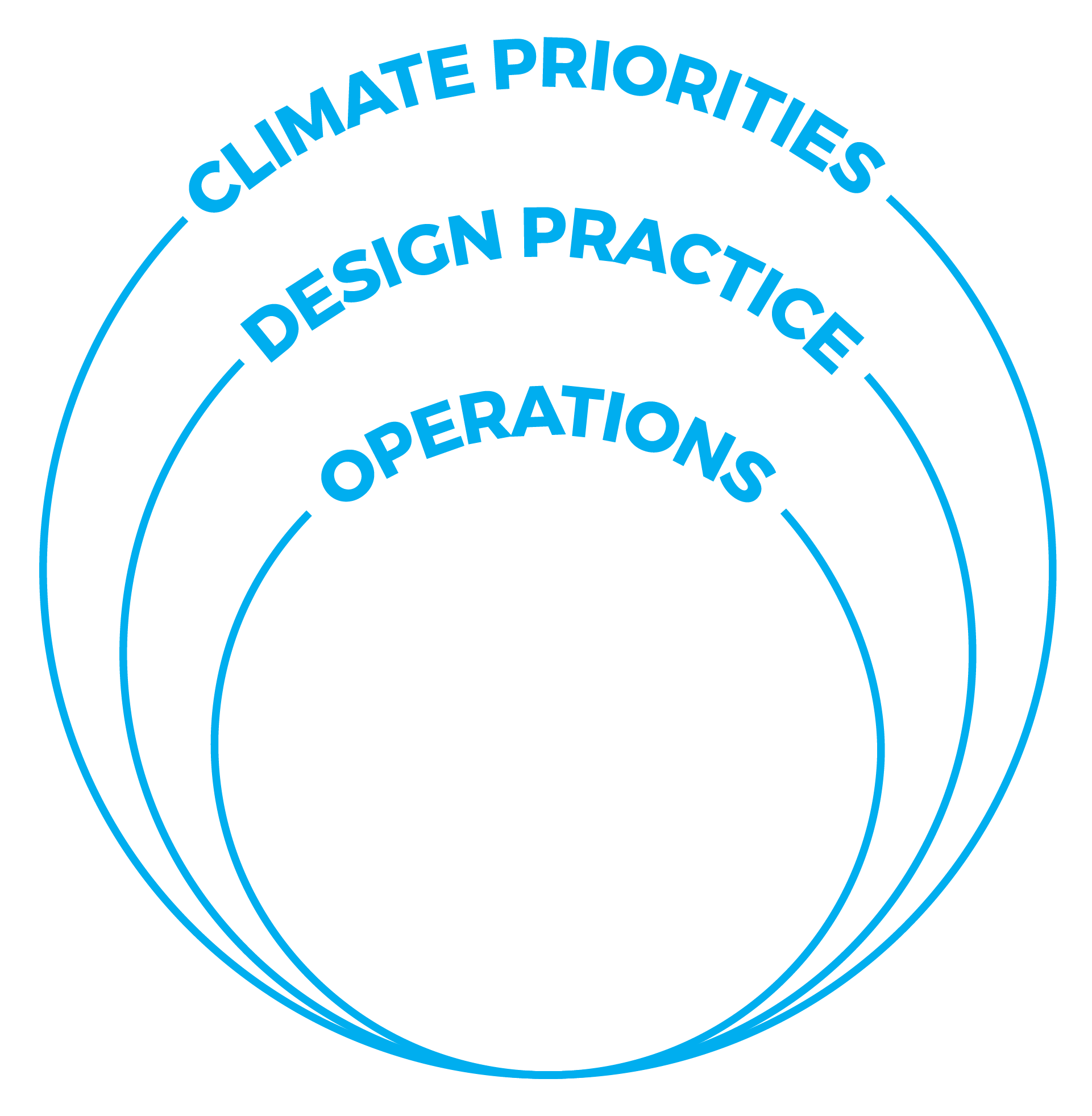Climate Action Plan
The Climate Action Plan at OLIN emerged from several years of internal office engagement and industry research. It is a framework that outlines our proactive stance on incorporating climate conscious design and operational practices into our work, from client relationships to site selection, design materials, performance, and office operations. It is a living document that we will build on year after year.
The Climate Action Plan is a project of OLIN Labs, OLIN’s research and development community of practice. It is part of OLIN Lab’s Year of Climate Action (2024), one of several staff-driven projects that exemplify OLIN’s commitment to carbon and waste reduction, and climate activism.
In 2023, OLIN held its first ever Climate Week series of programming. Inspired by the annual Climate Week in New York City that has taken place since 2009, OLIN hosted a five-day series of internal panels to increase awareness of the climate implications of the landscape architecture and planning work we undertake. This dialogue prompted the continuation of research and project based inquiries, and highlighted the need for stronger protocols and benchmarking.
One year later, during Climate Week 2024, OLIN was one of several firms that signed ASLA’s Climate Action Plan commitment to reduce carbon in operations and projects by 50% by 2030 and achieving zero emissions by 2040. Carbon accounting and tackling climate action in a holistic manner is the key to OLIN and other designers achieving these goals.
Please contact olinlabs@theolinstudio.com for a copy of the full Climate Action Plan v. 2025!
Expanding our Duty of Care
At OLIN, we understand the urgent challenges of our time and the intensifying dilemmas of our future. In our own communities, and those we serve through our practice, we witness the damage of unbearable heat waves, the devastation of wildfires, the unpredictability of storm events, and the inundation caused by rising waters and unrelenting downpours, often impacting those most vulnerable. These impacts are not distant threats; they are our present realities that are eroding the integrity of our living world and putting many at risk.
This Climate Action Plan represents a point of collective reflection on the impact of our work, our agency to positively shape the built and natural environment, and our commitment to expand our duty of care. By leveraging landscape architecture, planning and urban design into transformative actions, we aim to address these challenges head-on. These commitments are both internal to the operations of our practice and external to the work we do for others. Through research, collaboration, and design, we seek to create inclusive opportunities, mitigate harm, expand learning on new solutions that reduce environmental impacts, and contribute to a resilient future.
It is our time to move beyond acknowledgment to action. This Climate Action Plan is our pledge to lead with purpose, shaping spaces that honor ecosystems, uphold equity, and provide hope for generations to come. Together, we can redefine our role as stewards of the environment and advocates for a sustainable and inclusive future.
What is a Climate Action Plan?
A Climate Action Plan is first and foremost about reducing greenhouse gas (GHG) emissions. The industry standard of measuring GHGs is through scopes - Scope 1, 2 and 3 emissions. Emissions are the result of business operations, project types and locations, and the related inputs and outputs of each.
OLIN’s Climate Action Plan addresses the nuts and bolts of reducing GHG emissions through design materials, the built environment, business operations, and advocacy. As with many recent Climate Action Plans, there is a strong focus on carbon. OLIN’s Climate Action Plan also includes the fundamental drivers of our practice, and the areas where climate action goes far beyond carbon accounting and waste reduction – it is about protecting supporting and advocating for the people, species and natural environments where we work.
The Plan Pillars
OLIN’s Climate Action Plan is organized into three (3) pillars: Climate Priorities, Design Practice, and Business Operations. This reflects the way we approach our work, beginning with our mission to create spaces and communities that enhance life, working with like-minded clients and thought partners, and integrating a holistic approach to climate into our designs. Operations support our practice and ensure that our professional lives align with our mission and values.
CLIMATE PRIORITIES
Protect and enhance existing habitats and biodiversity
Incorporate natural, local, and low-carbon materials and prioritize reuse of onsite materials
Promote compact, transit-oriented development to reduce emissions, greenfield development, and the consumption of resources
Prioritize working in environmental justice communities and aspire towards equitable quality of life outcomes for all community members
Identify and address heat risks through environmental justice projects and design solutions
Approach community engagement through a lens of equity and inclusion
Maintain research and advocacy as fundamental to our practice
Implementation
The ASLA Climate Action Plan included a directive for “all practicing landscape architects and organizations achieve zero emissions—in scope 1, 2, and 3 emissions for projects and business operations—and double carbon sequestration as a profession by 2040.”
In September 2024, the LAF CEO Roundtable doubled down on the goals of the ASLA Climate Action Plan. As a leader in the field with a large global footprint, OLIN has the capability to influence other practices striving for reduced emissions. While tracking these metrics in totality is challenging, OLIN has begun monitoring several key data points that relate to operations specifically.
HOW IS THIS BEING IMPLEMENTED AT OLIN?
Establish a baseline and continually track progress towards ASLA Climate Action Plan goals
Create a climate action team to advocate for sustainable practices
Conduct carbon curriculum trainings quarterly
Update the climate action plan annually
Continually update carbon curriculum and include resources on OLIN’s knowledge share database
Include decarbonization goals in project pursuits
Hold ourselves accountable towards decarbonization
Please contact olinlabs@theolinstudio.com for a copy of the full Climate Action Plan v. 2025!
References & Resources
Calkins, M. (2025). Details and Materials for Resilient Sites: A Carbon Positive Approach, Routledge, in press.
Kuittinen, M., Organschi, A., & Ruff, A. (2022). Carbon: A Field Manual for Building Designers. Wiley.
Kuittinen, M., Hautamäki, R., Tuhkanen, E.-M., Riikonen, A., & Ariluoma, M. (2021). Environmental Product Declarations for plants and soils: How to quantify carbon uptake in landscape design and construction? The International Journal of Life Cycle Assessment, 26(6), 1100–1116.
Building Transparency Owners Climate Action Network (CAN) Embodied Carbon Action Plan
AGC Playbook on Decarbonization & Carbon Reporting in the Construction Industry.

















